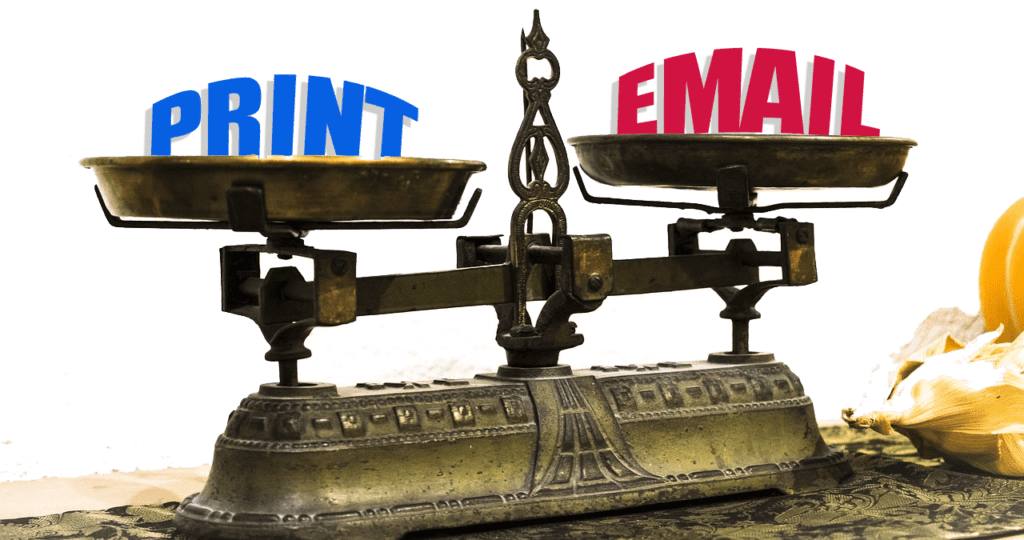This post is about monthly real estate newsletters sent for the purpose of client retention and follow-up, not for internet lead conversion. For the difference, see: What is a real estate newsletter?
Over the years, I’ve gone back and forth on the idea print vs. email newsletters for client retention. Today in 2019 I can say something I couldn’t say in 2009: Email newsletters are working.
In fact, email newsletters are more effective in some situations than print newsletters. That’s because people relate to print and email differently, and each form of newsletter has it’s strengths for both the agent sending it and the client reading it.
Understanding the differences can help you decide which to use and what to expect. Following are three benefits to using each type of newsletter, and a brief analysis of when you should consider using each type for your real estate clients.
3 Benefits of Using Monthly Print Newsletters
- Print newsletters have less competition for attention than email newsletters. The average person gets between 20 and 50 emails a day, compared to 3 to 7 pieces of print mail, much of which consists of bills or junk mail. If the print newsletter is from a trusted source, it tends to stand out in the same way a personal letter from a friend does. This makes print newsletters ideal for creating client loyalty and generating referrals.
- A printed newsletter has durability. It lays around on the counter, or gets stuck to the refrigerator with a magnet. Your recipients can look at it multiple times at a glance, without having to go out of their way to hunt for it on their phones. Email newsletters suffer from “out of sight, out of mind” syndrome, but print newsletters don’t have that problem. Many clients give referrals by just handing over their agent’s print newsletter.
- Studies have shown that people prefer to read multi-page documents in print rather than email. Print allows them to scan the information and focus on what they want to read. This is different from email newsletters, where only a small bit of the newsletter can be seen at one time. When readers scan their print newsletters, they can see the depth and breadth of your real estate expertise, even if they don’t read everything.
3 Benefits of Using Monthly Email Newsletters
- Email newsletters are about cost for most business owners. To send just 200 print newsletters can cost $300/mo. But you can send 2,000 email newsletters for free through the Mailchimp platform, and thousands more for less than the cost to mail your 200 printed email newsletters.
When you use Fast Newsletters with Mailchimp, your entire real estate newsletter cost is just $13 for up to 2,000 mailings!
- Email newsletters are nimble. If you have a new listing or a hot piece of information, you can send that right now. Print newsletters obviously can’t be that responsive.
- Email newsletters are interactive. Print can’t touch that. Email newsletters can include links to articles, games, property searches, calculators, and of course, your email and phone.
A downside to email is that it’s harder to get and keep someone’s attention than it is with print. Your content has to be spot-on to get them to at least open and scroll through some of your newsletter. If the content isn’t fun or relevant to them, they might simply send you to spam, and then you’re invisible to them. If you need good ideas for your email newsletter content, browse these content suggestion posts.
Which Newsletter Will Work Best?
OK, now that you’ve read through the pros and cons of each form of newsletter, which should you use? It might depend on who you’re sending to.
If your clients are predominately 55 and over, print might be your best bet. Not because of their age, but because they are more likely to be retired. And if they’re anything like my parents, they’re not looking at email very often. They’re not working, so they’re not at their desk. And they’re not browsing email on their phones. So if your target real estate market is 55+, then you’ll have better results with print newsletters.
If your clients are predominately 21 to 35 year old new home buyers, then email will be effective. Instead of just one monthly newsletter, more frequent emails per month would be ideal. You might consider splitting your newsletter into two newsletters per month.
If your clients are in the middle of their real estate life cycle, then a mix of email and print could be your best bet. You might consider segmenting your list into categories. Send print newsletters to the older clients, and to your hottest referral sources and best past clients. Then send email to everyone else.
Of course, if email newsletters are all you can afford, then it’s not really a question of which kind of newsletter is best. It’s best to send something rather than nothing. So if money is tight, at least send email newsletters!
Recap
In general, print newsletters generate more referrals and repeat business, perhaps due to a sense that print is more personal. Print is also durable, so it hangs around on someone’s countertop or attached to the refrigerator, reinforcing it’s message. But it’s expensive. Email newsletters are much cheaper, can be updated quickly, and can be sent multiple times a month. They work by repetition. Email newsletters create interaction through links to other content, and email makes it easy to contact you at the click of a button.
Whichever you choose to send, real estate newsletters are vital to building a stable, long-term real estate business. Don’t be afraid to change your newsletter strategy as your income, clients, and markets change.
